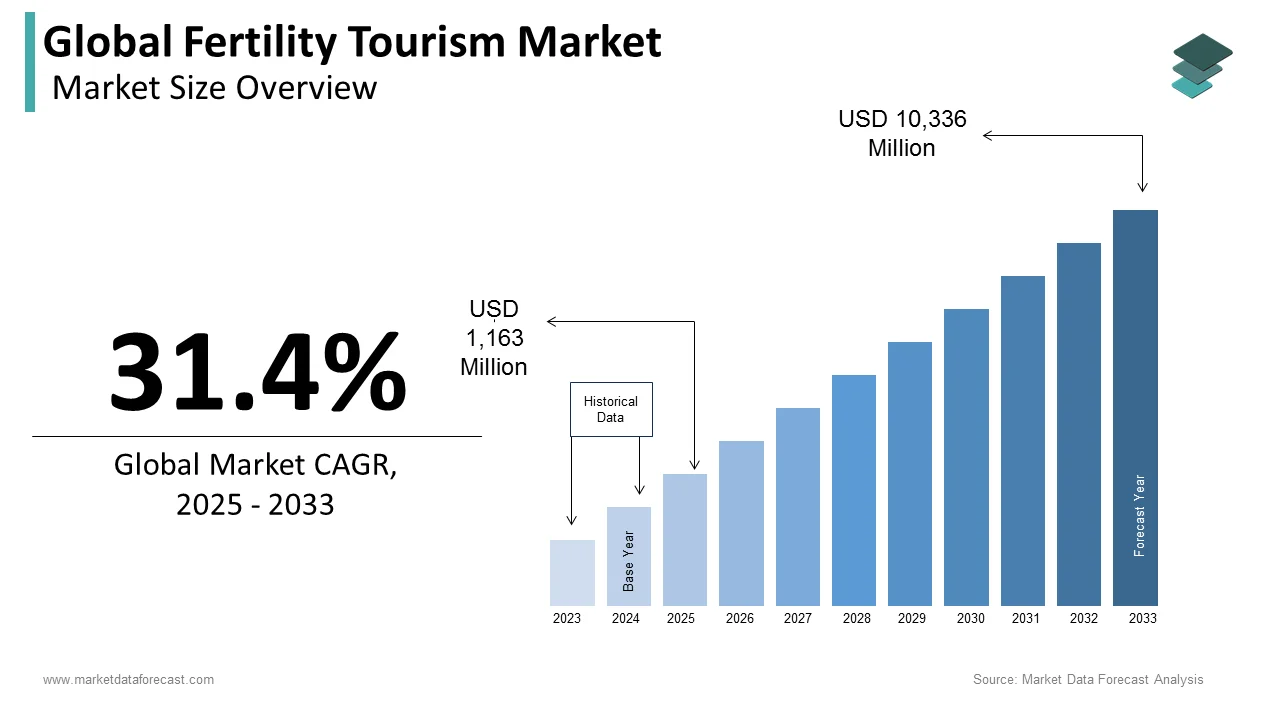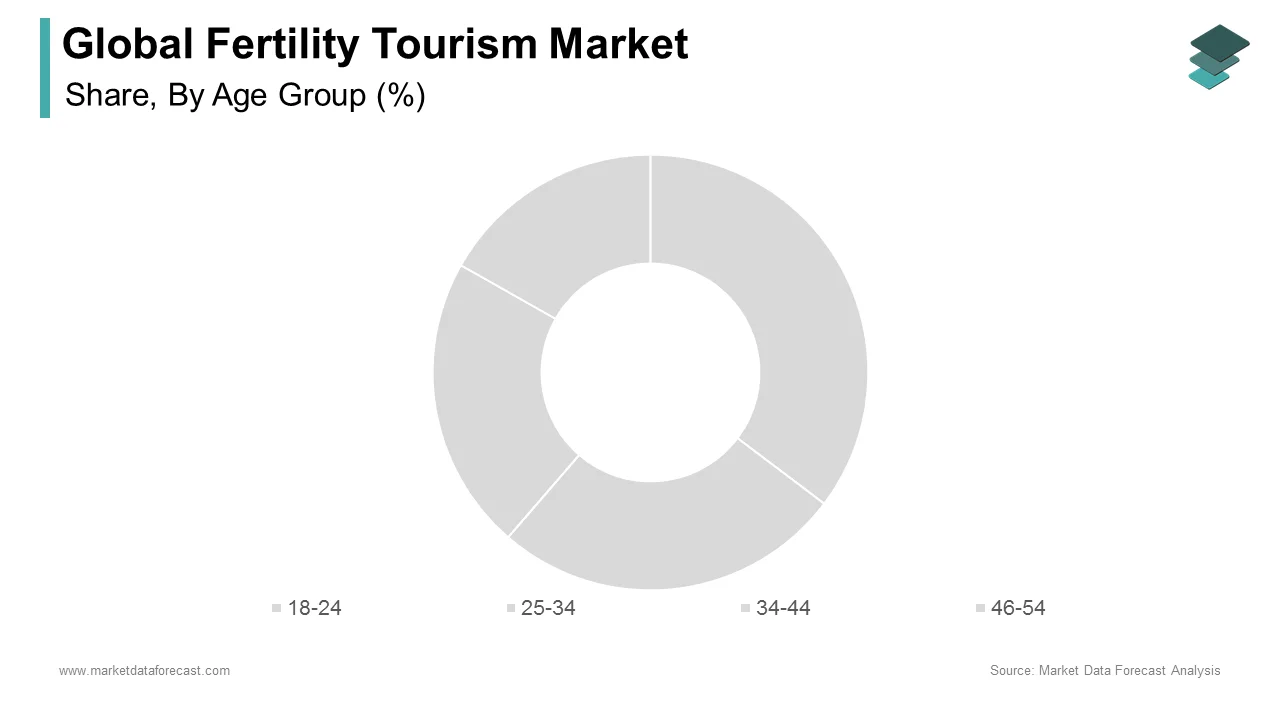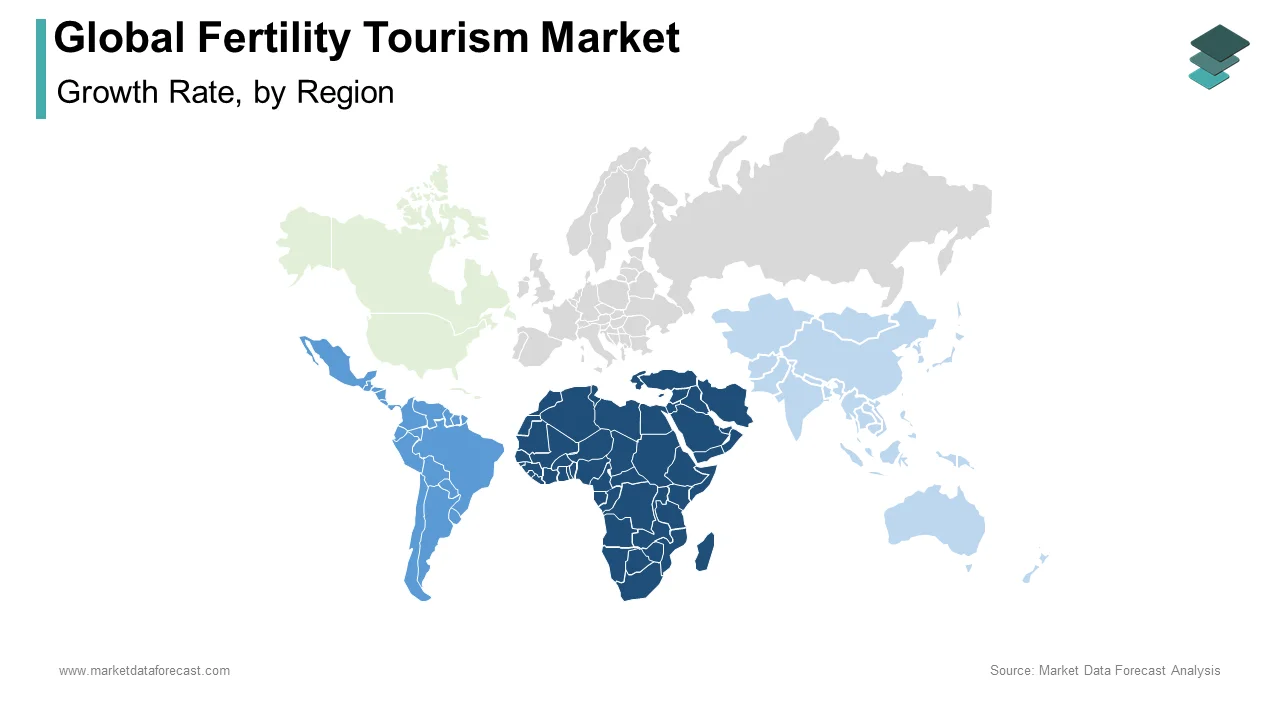Global Fertility Tourism Market Size, Share, Trends & Growth Forecast Report By Age Group and Region (North America, Europe, Asia-Pacific, Latin America, Middle East and Africa), Industry Analysis From 2025 To 2033.
Global Fertility Tourism Market Size
The size of the global fertility tourism market was worth USD 885.08 million in 2024. The global market is anticipated to grow at a CAGR of 31.4% from 2025 to 2033 and be worth USD 10,336 million by 2033 from USD 1,163 million in 2025.

Fertility tourism is a form of medical tourism where individuals from different countries travel outside of their origin countries to receive fertility care. Fertility is the medical term related to the reproductive health of an individual. It refers to the ability to conceive, sustain, and produce life in a pair. The fertility rates of a couple depend on the sexual health of both the female and the male partner. Several factors determine fertility in these genders; for example, the number of healthy eggs (ovum) produced in the ladies and the count and agility of the sperm produced in the male. Successful conception occurs when both genders have healthy systems. A fertility center/clinic or assistance is meant to help couples or individuals with problems with reproductive health and who cannot remain fertile. Fertility difficulties can occur due to multiple reasons. It is challenging to pinpoint the reasons without consultation.
MARKET DRIVERS
There is a growing demand for the market as the world reopens after the pandemic and international travel loosened up. However, fertility treatments can get extremely expensive as the cheapest treatment regime in the U.S. starts from around $10000. Therefore, there is a high demand for traveling to cheaper regions for an affordable fertility treatment regime. Furthermore, most insurance programs don't cover fertility treatment services in their coverage, making it difficult to pursue certain economic classes. Therefore, countries like Denmark, Spain, Turkey, Check Republic and others have the cheapest policies for fertility treatments leading to more markets for fertility tourism. Additionally, these countries maintain the treatment quality for the price and provide efficient treatment in lower price ranges.
The growing cases of infertility among the populations due to various health conditions are also leading to more demand for the market. According to WHO, approximately 17.5% of the adult population worldwide has fertility issues, meaning roughly 1 in 6 people worldwide. Therefore, the rising concerns with infertility and the growing number of patients for fertility treatments support the growth of the market during the forecast period. Several reasons can cause infertility in both men and women, and one of these reasons is lifestyle patterns that affect fertility rates. Therefore, the growing lifestyle changes and the prominence of habits like smoking, drinking, drugs, steroids, etc., leading to high blood pressure, have also resulted in infertility problems, supporting the market's growth. Additionally, the growing rates of obesity in the population are also caused g infertility as being overweight or underweight, and a lack of exercise can also cause problems with fertility leading to market retirement. Better care and treatment provided in fertility tourism, with less stringent regulations, fewer appointments and wait times, and efficient procedures, support the market's growth.
The growing rates of career-oriented populations and late marriages are also causing an increased need for fertility services. With growing age, the ability to reproduce effectively reduces, and as people marry later, it becomes difficult for them to conceive. For example, the average marriage age in America is 27.9 years, and the fertility rate starts declining around 30, especially in women. The rising stress and mental health issues obstructing fertility in people also support the market's growth. Furthermore, the growing rates of queer and same-sex couples trying to conceive are also leading to market growth. Lesbian couples need assistance in finding a suitable donor and egg retriever from fertility clinics to conceive, and gay couples need assistance from a surrogate to conceive. Therefore, the growing need for fertility assistance is pushing the growth of the fertility tourism market as more people opt to travel outside their countries for assistance.
MARKET RESTRAINTS
Many countries do not offer fertility services to certain people, for example, people above a certain age, homosexuals, unmarried people, single people, etc., and this rejection of service is a drawback to the market. Additionally, the flight and accommodation costs of traveling for fertility care are an extra burden that can only be affordable for some classes. Additionally, the patients of fertility clinics abroad must travel outside their country and comfort zone to deliver the baby, and they may miss the presence of their loved ones during the birth. Finally, many countries have a policy of not disclosing any information about surrogates to the parents, which is the main drawback of fertility tourism.
REPORT COVERAGE
|
REPORT METRIC |
DETAILS |
|
Market Size Available |
2024 to 2033 |
|
Base Year |
2024 |
|
Forecast Period |
2025 to 2033 |
|
Segments Covered |
By Age Group & Region |
|
Various Analyses Covered |
Global, Regional & Country Level Analysis, Segment-Level Analysis, Drivers, Restraints, Opportunities, Challenges; PESTLE Analysis; Porter's Five Forces Analysis, Competitive Landscape, Analyst Overview of Investment Opportunities |
|
Regions Covered |
North America, Europe, APAC, Latin America, Middle East & Africa |
SEGMENTAL ANALYSIS
By Age Group Insights

Based on age group, the 34-44 age group segment is expected to dominate the fertility tourism market during the forecast period due to the rising complications in fertility at this age. The rising complexity of giving birth and conceiving at these ages supports segment growth. Furthermore, the chances of miscarriage and abnormalities in the fetus in late pregnancy and the promises of higher success rates abroad support the segment's growth during the forecast period. Additionally, complexities like diabetes, stillbirths, and critical births, especially for women, lead to more markets in the segment. Furthermore, several foreign fertility clinics provide you with multiple donor options and more scope for pregnancy, leading to segment growth.
The 46-54 age group segment is also expected to grow due to the rising finances for people of this age group and the ability to spend more on fertility care. In addition, the high costs of advanced fertility care in the US and UK are leading to more demand for this age group. As these countries provide the best services and advanced care, they demand more investment, and the people in this age group are willing to make this expenditure, leading to growth for the segment.
REGIONAL ANALYSIS

The MEA region is expected to dominate the market during the forecast period due to the high quality of services provided at far lower costs than in the US. Countries like Turkey are considered one of the best places for fertility assistance as they have world-class services at low costs, and flying to the region is also relatively easy. Furthermore, more populations travel to the MEA region for treatments due to their credibility and services supporting the region's growth. There is a dominant influx of international visitors for medical care in the region, supporting the market's growth.
The Latin American region is also expected to grow due to more people traveling to these countries for fertility services. In addition, growing consumers from the European and North American regions in this area support the market growth. Countries like Spain, which have the highest number of patients and low costs, are expected to support the growth.
The Asia-Pacific market is also expected to grow due to countries like Thailand and Malaysia having the highest success rates in IVF treatments. In addition, these regions are famous for their medical care and fast results that support growth. Furthermore, aside from the influx of patients from other continents, these regions also welcome patients from China, as people travel to other countries due to China's one-child-per-family rule. The growing niche of fertility treatments in these regions supports the market's growth.
KEY MARKET PLAYERS
San Diego Fertility Center, IVF-Life, Barcelona IVF, Eva Fertility Clinics, The Surrey Park Clinic, Bumrungrad International Hospital, Assisted Reproduction and Gynecology Centre, Sincere IVF Center, Alpha IVF & Women's Specialists, Genesis IVF, Manchester Fertility Services Ltd and Apollo Fertility are some of the major players in the global fertility tourism market.
RECENT HAPPENINGS IN THE MARKET
- In April 2023, Dubai had a significant surge in medical tourism in 2022, with 674,000 patients spending $270 million (Dhs992 million), up Dhs262 million from the previous year. According to a survey by the Dubai Health Authority (DHA), 22% of medical tourists were from Europe and the Commonwealth of Independent States, 21% were from Arab and GCC nations, and 39% were from Asian nations.
- In May 2023, INVO Bioscience Inc. and Ming Mei Technology recently agreed to an exclusive distribution deal for the INVOcell intravaginal culture (IVC) system. This is anticipated to provide people in Taiwan with the most cutting-edge assisted reproductive treatments.
- In February 2023, the problem of infertility is something Bumrungrad International Hospital is aware of, and we understand that having children is vital to our patients. Therefore, our Fertility Centre & IVF Clinic offers complete reproductive care for couples looking to get pregnant, including consultations and assisted reproductive technology.
MARKET SEGMENTATION
This research report on the global fertility tourism market has been segmented and sub-segmented based on the age group, and region.
By Age Group
- 18-24
- 25-34
- 34-44
- 46-54
By Region
- North America
- Europe
- Asia Pacific
- Latin America
- Middle East and Africa
Frequently Asked Questions
What is the expected growth rate of the global fertility tourism market?
The global fertility tourism market is estimated to grow at a CAGR of 31.4% from 2025 to 2033.
What factors contribute to the growth of the fertility tourism market?
Factors contributing to the growth of the fertility tourism market include advancements in reproductive technologies, increasing awareness and acceptance of assisted reproductive techniques, international accessibility, favorable legal frameworks, and cost differentials for treatments.
What are the popular destinations for fertility tourism in Europe?
Popular destinations for fertility tourism in Europe include countries like Spain, Greece, Czech Republic, and Cyprus, known for their well-established medical infrastructure and favorable regulations for reproductive treatments.
What are the reasons for the United States' prominence in the fertility tourism market?
The United States holds prominence in the fertility tourism market due to its advanced reproductive technologies, experienced healthcare professionals, high-quality medical services, and a wide range of available treatments.
Which countries in Asia-Pacific are known for fertility tourism?
In Asia-Pacific, countries such as India, Thailand, and Malaysia are known for fertility tourism due to their combination of advanced fertility treatments and comparatively lower costs.
What are the emerging destinations for fertility tourism in Latin America?
Emerging destinations for fertility tourism in Latin America include countries like Mexico, Brazil, and Argentina, which offer a combination of quality medical care, affordable treatment options, and attractive tourism destinations.
Related Reports
Access the study in MULTIPLE FORMATS
Purchase options starting from $ 2500
Didn’t find what you’re looking for?
TALK TO OUR ANALYST TEAM
Need something within your budget?
NO WORRIES! WE GOT YOU COVERED!
Call us on: +1 888 702 9696 (U.S Toll Free)
Write to us: [email protected]
